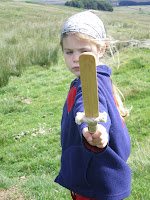.JPG) Nicola, Pete, Lola and Nell want to travel the world with a difference. We hope to get a taste of many countries without adding to climate change (with needless emissions from aeroplanes) or having to waste hours of holiday time in airport terminals. We hope our adventures inspire you to take a Grand Tour of your neighbourhood. This post is from Nicola
Nicola, Pete, Lola and Nell want to travel the world with a difference. We hope to get a taste of many countries without adding to climate change (with needless emissions from aeroplanes) or having to waste hours of holiday time in airport terminals. We hope our adventures inspire you to take a Grand Tour of your neighbourhood. This post is from Nicola"There's nothing there,
nothing left of the castle," says the farmer rather suspiciously. I've turned up at a bleak farmhouse above the little village of Pennan (famous for its star role in the movie
Local Hero) trying to untangle the Baird story on this gorgeous bit of Banff coastline. No wonder Wendy is finding it hard to look me in the eye... the castle was trashed after William Baird of Auchmedden bankrolled the wrong side. In other words he supported Bonnie Prince Charlie (the English called him the Young Pretender) in the 1745 Jacobean uprising. This all ended horribly for the Scots (and Charlie's ambitions) at Culloden in 1746.
As a result the Baird family lost the family estates and never really made good again. Still they'd had a good run seeing as they were orginally from Normandy and had gained a castle site, land, money etc as a result of being on the winning side when they came over with William the Conqueror in 1066.
Earlier in the day we'd been round the huge Scottish National Trust owned
Haddo House (castle-sized!) which is owned by the Gordon family. They too had joined the Jacobites but somehow managed to get their land back, perhaps by being a little more politically "slippery". However in the Victorian reworking of the interior the five
-petalled Jacobite dog rose is proudly used for mouldings on staircases, ceilings, tall boys (cupboards) and even bedsteads, just occasionally you find a rose with six-petals - that's the Tudor rose,clearly put up to keep the Royal visitor (Queen Victoria) and other more English-oriented politicians happy.
In one of the lesser rooms there are
63 watercolours of the castles that used to exist in the county of Aberdeenshire - so I've a fair idea of what a
Bonnet Laird castle, such as the one the Baird family built, looked like - straight up sides with the door on the upper floor. Frustratingly Penan is just on the Banffshire side so there is no watercolour of the old Auchmedden castle.
It took me nearly two hours to drive up to the Banff coast in our borrowed car, and it feels light years away from the rest of Scoltand (eg, Edinburgh), let alone London, England. Up here the climate is different,
you can see the Northern Lights and you feel a long way from everywhere else. No wonder these lairds answered the chaotic, but charismatic Bonny Prince Charlie's call to arms. You couldn't believe you'd lose.
The current farmhouse -
Mains of Auchmedden - looks grey and unwelcoming but the farming couple are willing to chat for a bit over the gate about their cattle. They breed
Charolais bulls which are famously enormous. The one in the yard seems to tower over its pen rails and he isn't even a year and one of their prize-winners, Hercules, weighed in at 1,700 kilos. Given that they have so many bulls there's no question of sauntering on to their land (allowed in Scotland!) as we might be seen off in a very undignified, scary manner.
The children have been excited about visiting this spot since we started planning the trip and I feel disappointed that we can't really show them anything, not even a stone. What we need is
Time Team to do a dig... Then Wendy tells us that when the Bairds are living at Auchmedden there are always sea eagles - the biggest bird in Britain. The kids and I watched a programme about these enormous white-tailed birds only the other night on TV so we all start paying attention. "I've not seen any," points out Wendy honestly, "I see all sorts from my kitchen window when I'm washing up - boats, porpoises..." It is nice to think of Wendy's spectacular view as she sorts out the dishes.
My line is a junior Baird (as my mum has always put it), more info at
http://www3.nbnet.nb.ca/islands/clan.baird/hamish.htm, we belong to the Bairds of Newbyth - excitingly New Byth is just seven miles inland. But William of Auchmedden is a direct ancestor and I am wearing the ring with part of his coat of arms. "Is that a seal?" says Wendy looking at the bloodstone moulding near my wedding band, and in a spectacular piece of stupidity I answer, "No, it's a boar actually."
We ought to laugh but we've only just met in the most peculiar of circumstances - I'm looking for a long gone castle and her home is her castle. I can hear her husband talking in the shed, a little boy is playing in a tractor trailer (a sort of safe child pen) and the nearest bull is listening to the radio.
Her husband comes over and together they show us on our OS map where the remains of the castle should be. I make a cross in black ink.
Then I show Wendy a photo my mum took 10 years ago of a plaque:
"DOMINUS FECIT
Erected to the memory of William Baird, of Auchmedden, Esq, chief of that ancient name. His participation in the rising of 1745 occasioned tohim and his descendants the loss of the family estates, he died at Aberdeen 1777 aged 76. And of his wife Anne Duff, sister of William Earl of Fife, who died 1773, aged 68. And also of Henrietta their daughter, spouse of Francis Fraser Esquire of Findrack, who died 18 July 1801."
"Do you know where it is?"
Wendy and her husband confer - he in such a strong Scottish accent that it might as well be another language. They aren't sure, but give some suggestions away to the west. I have a hunch we should be looking east.
I curse myself for not
pestering my mum with minutae of where to find things. Scotland is so big and there are several churches nearby. We've already looked at one in eroded red sandstone and there was zilch. Ripe for conversion? Next door the old school house had already been turned into a family home with
dog and washing line.
We take a few timid snaps of the farmhouse and then head into Pennan. The first Baird had built the harbour, but though this is my second visit (pilgrimage?) I can't find the plaque in the photo or any reference to his harbour works.
The pub, in new hands, is the
Pennan Inn, and as it's early evening during holiday season the only punters are visitors. Ten years ago I'd propped up the bar with a very drunken oil worker who was back home for shore leave. When I asked, innocently, if there were any sea eagles on the cliffs, he started telling me the story about how there will only be sea eagles when there are Bairds at Auchmedden. It was amazing to be told back a family legend - and now it's happened twice. I hope all Bairds on the family trail are as lucky...
After William was chucked off the castle eventually ended up with Lord Haddo (of Haddo House) who married a Miss Christian Baird (our line) and that's when the
sea eagles took up residence again. But I think they were childless - the result the castle (perhaps by now a house not a fortress) was sold to four Baird brothers who'd made their money in
Glasgow shipping. I think they have more descendants than my line...
It's time to go home - I pop a symbolic fiver into the harbour collecting box - and then we head off towards big roads. It's quite dark for 7pm, the rain is drawing in, and I'm still not well - wheezing and hawking if I move too suddenly. As we drive past the Mains of Auchmedden I
hear tooting - it's from the farmer in the field. He's driving the green tractor now, and Wendy is running behind. We give a big wave. It's a shame we can't join these ancestral dots...
About 10 miles drive down the road I force myself to turn the car around and go back and look. There's a sign that says Old Kirk - and ancient writing on the map. Maybe that's it? The graveyard is well cared for - lots of graves, and close mown grass - but the church is a ruin with no roof. We run around as if we are on a treasure hunt looking for the polished granite plaque. And then bingo - Pete spots a small roofless room at the seaward end, its floor carpeted by five different green mosses.
Inside there's not just our plaque, but three more all with Baird mottos.
This is the family vault!It's run down, the sandstone is being washed away but I can just see the boar, some stars, a spade (that's a new one). Lola and Nell start to interpret: there's a horse because you like riding, tools for growing your veg, a boar - well that's obvious, ha ha, and so they go on interpreting family history with huge pleasure; matching mum to
memento mori.





.JPG)
.JPG)
.JPG)
.JPG)
.JPG)
.JPG)
.JPG)

.JPG)
.JPG)
.JPG)
.JPG)
.JPG)
.JPG)
.JPG)
.JPG)
.JPG)
.JPG)

.JPG)
.JPG)
.JPG)
.JPG)
.JPG)
.JPG)
.JPG)
.JPG)
.JPG)



